
Original Link: https://www.anandtech.com/show/2253
3RSystem iCEAGE: A New Cooling Company Tackles the Heatpipe Tower
by Wesley Fink on June 21, 2007 12:02 AM EST- Posted in
- Cases/Cooling/PSUs
When Zalman first burst onto the silent PC and Cooling markets a few years ago, many were surprised to find the company headquartered in South Korea. The kind of innovative thinking Zalman brought to the market in those early days usually came from Japan and then migrated to Taiwan. However, Korea was developing in many manufacturing areas and it was more logical than we first imagined finding an innovative new computer cooler company designing and manufacturing in Korea.
Today, a Korean headquarters is not as unusual as it was just a few short years ago. So it came as no surprise that a well-known case company headquartered in Korea, namely 3RSystem, has now entered the CPU cooling market. This is a natural extension of their work in case design and their first products are based on the latest design thinking in air cooling.
3RSystem was established in South Korea in 2000, with the goal of using creative design and innovation to become a competitive case manufacturer in a very short time. Evidence that this was achieved was the appointment of 3RSystem in 2001 as a "company of technological excellence".
From those beginnings 7 years ago the 3R Product Line has grown to include a full line of mini tower, full tower and mini/slim cases. 3RSystem also markets Poseidon brand water cooling systems, and they have just launched their iCEAGE CPU air coolers.
3RSystem products are now sold around the world, and frankly the company's presence in some Asian and European markets is much larger than their US presence. You can find more information on the availability of products in your area at the 3RSystem web site. According to 3RSystem, sales and distribution in the US are handled through JustPC (USA) located in Ontario, California. A quick click to the JustPC website shows a close link with 3RSystem featured on the introductory page.
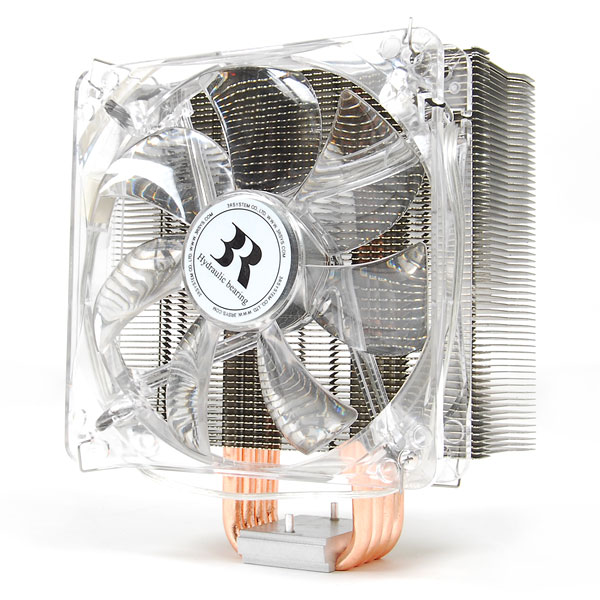
The iCEAGE, which is the subject of this review, is an air cooler based on the capable heatpipe tower design. A full cooling test should provide a very good idea of the capabilities of the iCEAGE and how it compares to the best coolers tested in the AnandTech cooling labs.
3RSystem iCEAGE
Cooler packaging can take many approaches to presenting a product. You find tiny coolers in gigantic boxes, a standard shape for a company's entire product line, plain simple brown cardboard as a design statement, and packaging that tries to do everything at once, as just a few approaches. The iCEAGE is a particularly nice package design since the box shape - wide and shallow - mirrors the shape of the cooler inside.
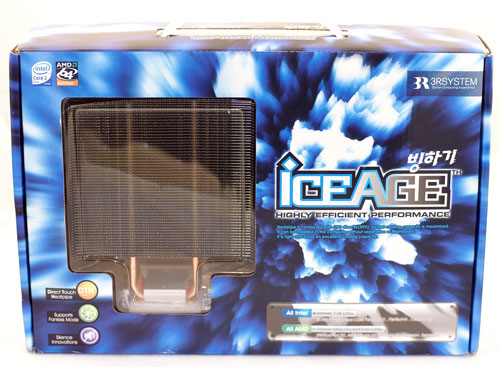
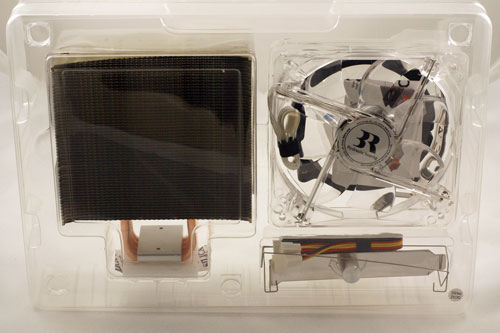
Of course you are buying a cooler, not a package, and inside the package is a protective clear plastic molded box that protects the individual components. It is also nice to see a Quality Assurance inspection sticker on the package.

The cooler uses large horizontal serrated aluminum fins soldered to four heat pipes in an upright heatpipe tower configuration. The serrated fins increase the surface area of the cooling fins. Active cooling is by a 120mm fan that can be swapped for another fan if your wish. However, the iCEAGE fan has a built-in speed adjustment that can be mounted in an empty PC slot. The high-quality rheostat can vary the fan speed from 1000rpm to 2200rpm, with resulting air flow of 53.5cfm to 78.5cfm.
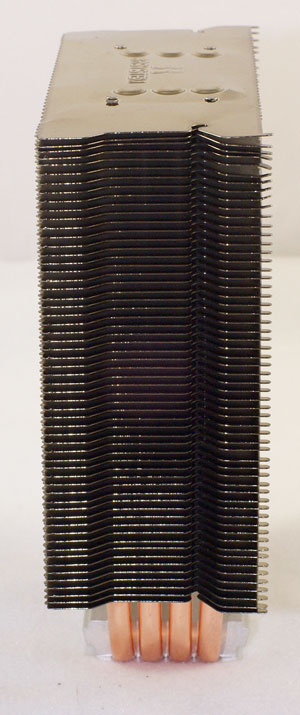
The fan is crystal clear and contains a blue LED to decorate your system interior with cool blue light. If you don't like the fan or LED any 120mm fan can be substituted, and standard 25mm fans will mount fine with the included fan clips.
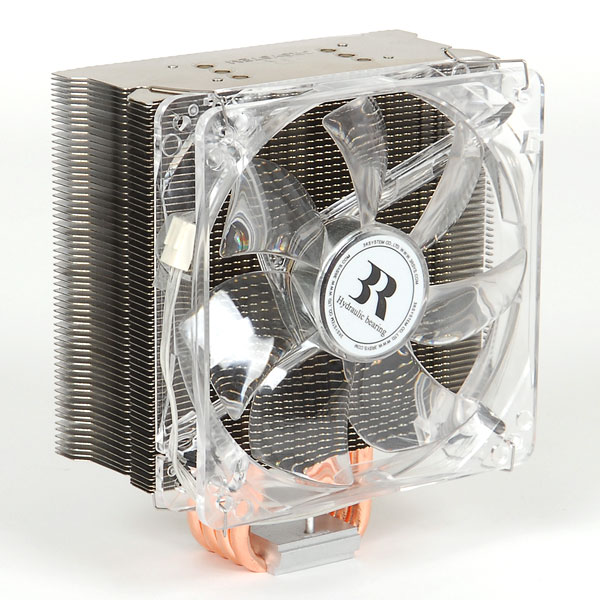
If you look closely at the fin cuts on top you can see that the iCEAGE is a single fan design. 3RSystem did not cut the groves into the back fins to mount a second 120mm fan for a push-pull cooling arrangement. We have found in other heatpipe towers like the Scythe Infinity that a second fan can often further improve cooling. It would be a simple matter for 3RSystem to more deeply "groove" the cooling fins so a fan could be optionally mounted on either side of the iCEAGE cooler for flexibility and the push-pull option.
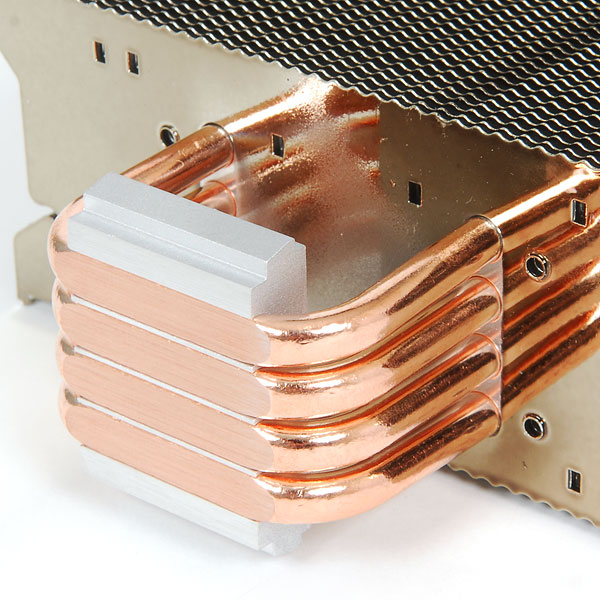
3RSystem exposes the heatpipes for direct contact with the CPU. They claim this can provide better cooling but we found no real evidence of better cooling with direct heatpipe contact.
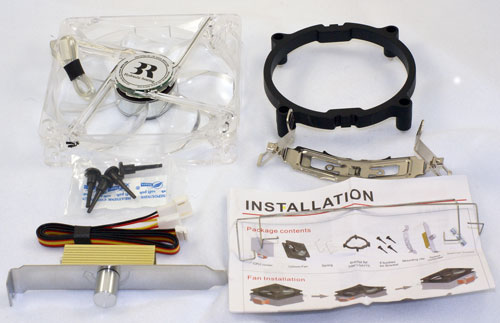
Accessories include a mounting bracket for Intel socket 775 and a spring clip that fits either the 775 base or the AMD 754/939/940/AM2. Mounting of either Intel or AMD processors is very simple. The Intel 775 base uses a unique and very secure push-pin setup. The pins on the 775 lock very securely and you can actually mount this cooler on any motherboard we tried while it is still installed in the case.
Mounting is very simple and very effective - even with a mounted motherboard. Our only real complaint is that while there are holes in the clip to align with pins on the top of the cooler CPU base, the pins on the CPU base were hardly even raised. This made mounting securely with no turning of the cooler very difficult. If 3RSystem plans to use alignment pins, which is a good idea to prevent shifting, they need to make them taller so they mate easily with the clip. Another option is to attach the spring clip to the base since it is used in all mount configurations.
Specifications
Our test system is Intel socket 775, but the 3RSystem will mount on any recent AMD socket as well - including 754/939/940 and AM2. The AMD clip attaches directly to any recent AM2/AMD processor cage that comes with your motherboard. All the needed hardware is included, and installation is very easy.
| 3RSystem iCEAGE Specifications | ||||
| Heatsink | ||||
| Dimensions | 126(W) X 75(D) X 150(H)mm | |||
| Weight | 590g | |||
| Material | Pure Copper Base and Aluminum Fins | |||
| Heatpipes | Four copper heatpipes | |||
| Fan | ||||
| Fan Size | 120 mm x 25mm | |||
| Bearing Type | Hydramatic | |||
| Fan Life | 30,000 hours | |||
| Connector | 3-pin with integral fan-speed rheostat, 0.38A (max) | |||
| Thermal Resistance | 0.1 C/W MAX | |||
| Speed | Lo Speed | 1,000rpm | Hi Speed | 2,200rpm |
| Noise Level | Lo Speed | 19dBA | Hi Speed | 32dBA |
| Fan Output | Lo Speed | 53.5cfm | Hi Speed | 78.5cfm |
The iCEAGE, like all heatpipe towers, is relatively large, but it is very shallow in depth like the Thermalright Ultra-120 and Ultra-120 eXtreme. The EVGA 680i is a difficult to fit board due to the copper-finned heatsink and fan cooling the Northbridge. The iCEAGE just cleared the Northbridge heatsink/fan, but it really had no mount issues on the 680i. Installation was also an easy task on the ASUS Striker and ASUS Commando, and on the two new ASUS P35 boards - the P5K Deluxe and P5K3 Deluxe. The P5K3 Deluxe is almost a fit test for any motherboard, since the heatpipes completely circle the CPU socket and connect various cooling heatsinks around the CPU socket.
CPU Cooling Test Configuration
The standard test bed for cooling tests is the EVGA NVIDIA 680i SLI motherboard. This is primarily based on the consistent test results on this board and the NVIDIA Monitor temperature measurement utility, which is part of the nTune program.
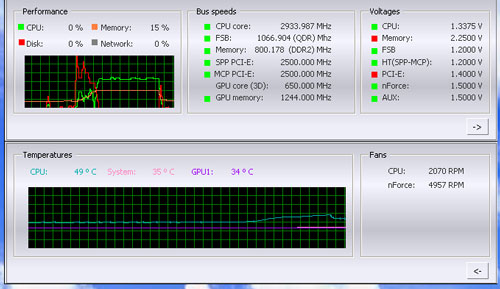
NVIDIA Monitor has a drop-down pane for temperature measurement which reports CPU, System, and GPU measurement. At this point reviews will concentrate on CPU temperature. In addition to the real-time temperature measurement, NVIDIA Monitor also has a logging feature which can record temperature in a file in standard increments (we selected every 4 seconds). This allows recording of temperatures during testing, which can then be reviewed when the stress tests are completed. There is also the handy reference of speeds and voltages in the top pane to confirm setup.
NVIDIA Monitor was compared to test results from the Intel TAT (Thermal Analysis Tool). Intel TAT CPU portions do function properly on the EVGA 680i motherboard, but the chipset-specific features do not operate as they should. Idle temperatures in TAT were in line with measured idle temps with NVIDIA Monitor. The CPU stress testing with TAT pushing both cores showed TAT stress temps at 80% CPU usage roughly corresponded to temps reported in our real-world gaming benchmark.
Other components in the cooling test bed are generally the same as those used in our motherboard and memory test bed:
| Cooling Performance Test Configuration | |
| Processor | Intel Core 2 Duo X6800 (x2, 2.93GHz, 4MB Unified Cache) |
| RAM | 2x1GB Corsair Dominator PC2-8888 (DDR2-1111) |
| Hard Drive(s) | Hitachi 250GB SATA2 enabled (16MB Buffer) |
| Video Card | 1 x EVGA 7900GTX - All Standard Tests |
| Platform Drivers | NVIDIA 9.53 |
| NVIDIA nTune | 5.05.22.00 (1/16/2007) |
| Video Drivers | NVIDIA 93.71 |
| CPU Cooling | 3RSystem iCEAGE Thermaltake Big Typhoon VX Thermaltake MaxOrb Scythe Andy Samurai Master Cooler Master Gemini II Noctua NH-U12F ASUS Silent Square Pro Scythe Ninja Plus Rev. B OCZ Vindicator Thermalright Ultra-120 Extreme Thermalright Ultra-120 Scythe Infinity Zalman CNS9700 Zalman CNS9500 Cooler Master Hyper 6+ Vigor Monsoon II Lite Thermalright MST-9775 Scythe Katana Tuniq Tower 120 Intel Stock HSF for X6800 |
| Power Supply | OCZ PowerStream 520W |
| Motherboards | EVGA nForce 680i SLI (NVIDIA 680i) |
| Operating System | Windows XP Professional SP2 |
| BIOS | Award P26 (1/12/2007) |
All cooling tests are run with the components mounted in a standard mid-tower case. The idle and stress temperature tests are run with the case closed and standing as it would in most home setups. We do not use auxiliary fans in the test cooling case, except for the Northbridge fan attached to the 680i for overclocking. Room temperature is measured before beginning the cooler tests and is maintained in the 20 to 22C (68 to 72F) range for all testing.
3RSystem provided a small packet of white thermal compound with the iCEAGE. We tested the iCEAGE with our standard premium silver-colored thermal compound. In our experience the thermal compound used makes little to no difference in cooling test results. This is particularly true now that processors ship with a large manufacturer-installed heatspreader. Our current test procedure uses this standard high-quality silver-colored thermal paste for all cooler reviews.
We first tested the stock Intel cooler at standard X6800 speed, measuring the CPU temperature at idle and while the CPU was being stressed. We stressed the CPU by running continuous loops of the Far Cry River demo. The same tests were repeated at the highest stable overclock we could achieve with the stock cooler. Stable in this case meant the ability to handle our Far Cry looping for at least 30 minutes.
The same benchmarks are then run on the cooler under test at stock, highest stock cooler OC speed (3.73GHz), and the highest OC that could be achieved in the same setup with the cooler being tested. This allows measurement of the cooling efficiency of the test unit compared to stock and the improvement in overclocking capabilities, if any, from using the test cooler.
Noise Levels
In addition to cooling efficiency and overclocking abilities, users shopping for CPU cooling solutions may also be interested in the noise levels of the cooling devices they are considering. Noise levels are measured with the case on its side using a C.E.M. DT-8850 Sound Level meter.
This meter allows accurate sound level measurements from 35bdB to 130dB with a resolution of 0.1dB and an accuracy of 1.5dB. This is sufficient for our needs in these tests, as measurement starts at the level of a relatively quiet room. Our own test room, with all computers and fans turned off, has a room noise level of 36.4dB.
Our procedures for measuring cooling system noise are described on the page reporting measured noise results comparing the stock Intel cooler and recently tested CPU coolers to the 3RSystem iCEAGE.
Cooling at Stock Speed
Some users will never overclock their CPU, but they still want to run the coolest CPU temperatures possible to enhance stability and extend CPU life. The 3RSystem iCEAGE comes with a high-quality slot-mounted rheostat coupled to a high-output fan. Therefore we tested the iCEAGE with the supplied fan and rheostat.
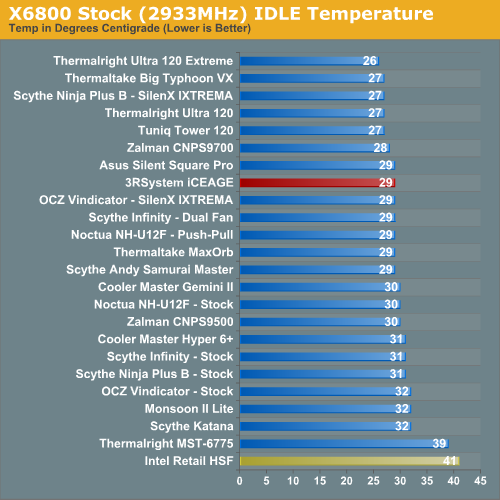
Where the very good Intel stock cooler keeps the X6800 at 41C at idle, the iCEAGE managed 29C, which is among our top performers. This is a significant improvement over the Intel stock cooler performance at 41C, and results are 3C short of the best we have tested. The Thermalright coolers, at the top of our heatpipe tower performance charts, cool to 26C and 27C, and the Tuniq 120 maintains 27C. The iCEAGE is competitive in cooling at stock idle speed.
It is more difficult to effectively simulate a computer being stressed by all of the conditions it might be exposed to in different operating environments. For most home users CPU power is most taxed with contemporary gaming. Therefore our stress test simulates playing a demanding game.
The Far Cry River demo is looped for 30 minutes and the CPU temperature is captured at 4 second intervals with the NVIDIA Monitor "logging" option. The highest temperature during the load test is then reported. Momentary spikes are ignored, as we report a sustained high-level temp that you would expect to find in this recording configuration. This test configuration roughly equates to an 80% CPU load test using Intel TAT.
Cooling efficiency of the 3RSystem iCEAGE is then compared under load conditions at stock speed to the retail HSF and other recently tested CPU coolers.
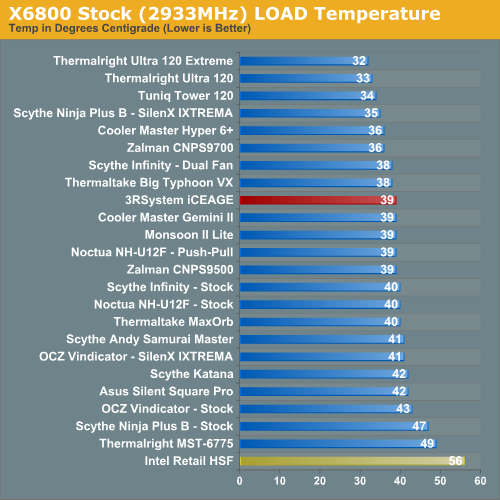
The iCEAGE under load at stock speeds reached a maximum temperature of 39C with the included fan at highest speed. This compares to the Thermalrights at 32C and 33C, the Tuniq at 34C and the Cooler Master Hyper 6+ and Zalman 9700 at 36C. Stock load performance is average at best among tested coolers.
We strongly suspect results with the iCEAGE would have been comparable to the Scythe Infinity had we been able to mount two fans in a push-pull configuration. However, 3RSystems will need to slightly modify the cooling fins to allow the option of two-fan mounting.
Scaling of Cooling Performance
The iCEAGE performance was decent at stock idle and average among top coolers at stock load. As overclocks were raised, the exhibited iCEAGE performance was not particularly outstanding in the ability to cool the CPU under stress conditions. To be as fair as possible all overclocking tests were run with the iCEAGE fan at the highest speed.
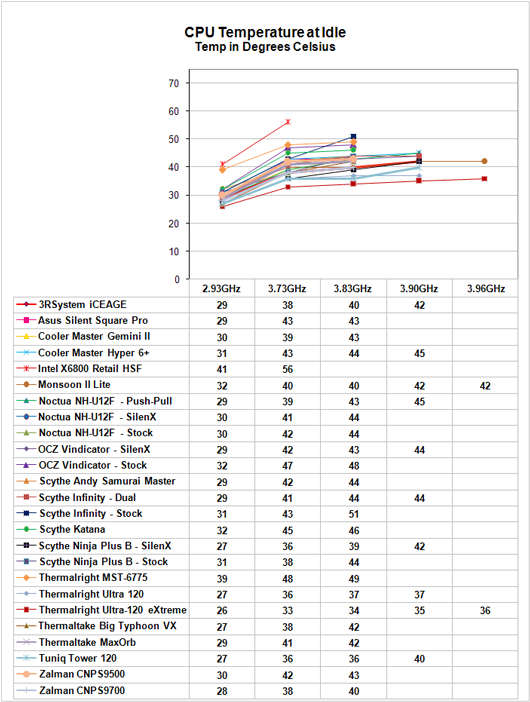 |
| Click to enlarge |
At 2.93GHz the retail HSF is running at 41C, compared to 29C with the iCEAGE. This is a delta of 12C. The delta becomes greater as the overclock increases. At 3.73GHz the idle with the retail fan is 56C compared to the iCEAGE at 38C - a delta of 18C. The cooling performance of the iCEAGE is much better than the Intel retail cooler at idle, but it does not reach the same cooling levels measured with the Thermalrights (with a Scythe S-Flex SFF21F fan) or the stock Tuniq 120. The top Thermalright Ultra-120 eXtreme, for example is at 33C at the same 3.73GHz.
Cooling efficiency of the 3RSystem iCEAGE was compared under load conditions to the retail HSF and other recently tested CPU coolers. Load testing can be very revealing of a cooler's efficiency. A basically flat line, particularly form 3.73GHz upward, indicates the cooler is still in its best cooling range. A line that is increasing rapidly indicates a cooler nearing the end of its ability to cool efficiently. Lines which parallel the best coolers over a range of values are indicate that the coolers have similar cooling efficiency.
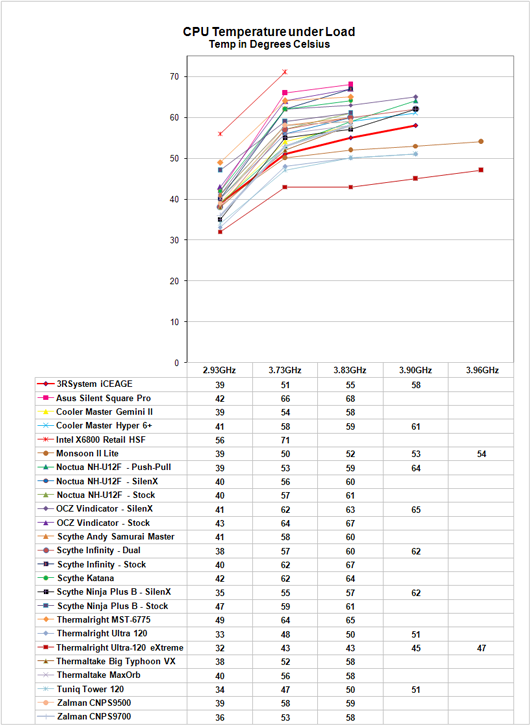 |
| Click to enlarge |
The iCEAGE is very efficient in cooling in the 2.93 GHz to 3.83 GHz overclock range. As you can see in the chart the cooling is almost a horizontal line in this range. The iCEAGE continues on to a highest overclock of 3.87GHz, which is just short of the 3.90GHz to 3.94GHz most of the top coolers in our testing have achieved. The slope of the iCEAGE in this range is up slightly, indicating it is nearing the end of its range of efficient cooling.
The 3.87 GHz with the iCEAGE tied several heatpipe towers with a single fan - in both cooling efficiency and overclock. It is likely the iCEAGE could do 3.90GHz like other heatpipe towers if it had the ability to mount two fans in a push-pull arrangement. At 3.87 GHz the cooling temperature with the iCEAGE was 58C. This compares to the Thermalright Ultra-120 eXtreme at the higher 3.94 GHz at 47C, 45C at 3.90GHz, and 43C at 3.83 GHz. The Tuniq 120 is 51C at 3.90 GHz.
The iCEAGE is not in the same cooling category as the best heatpipe towers we have tested, but it is a decent cooler to the range just below the best. Cooling efficiency is similar to other second tier heatpipe towers tested with just one fan.
As stated many times, the overclocking abilities of the CPU will vary at the top, depending on the CPU. This particular CPU does higher FSB speeds than any X6800 we have tested, but the 3.90GHz top speed with the Tuniq 120 is pretty average among the X6800 processors we have tested with Tuniq cooling. A few of the other processors tested with the best air coolers reach just over 4.0GHz, but the range has been 3.8 to 4.0GHz. Stock cooling generally tops out 200 to 400 MHz lower, depending on the CPU, on the processors tested in our lab.
Overclocking
As cooling solutions do a better job of keeping the CPU at a lower temperature, it is reasonable to expect the overclocking capabilities of the CPU will increase. In each test of a cooler we measure the highest stable overclock of a standard X6800 processor under the following conditions:
CPU Multiplier: 14x (Stock 11x)
CPU voltage: 1.5875V
FSB Voltage: 1.30V
Memory Voltage: 2.20V
nForce SPP Voltage: 1.35V
nForce MCP Voltage: 1.7V
HT nForce SPP <-> MCP: Auto
Memory is set to Auto timings on the 680i and memory speed is linked to the FSB for the overclocking tests. This removes memory as any kind of impediment to the maximum stable overclock. Linked settings on the 680i are a 1066FSB to a DDR2 memory speed of DDR2-800. As the FSB is raised the linked memory speed increases in proportion. The same processor is used in all cooling tests to ensure comparable results.
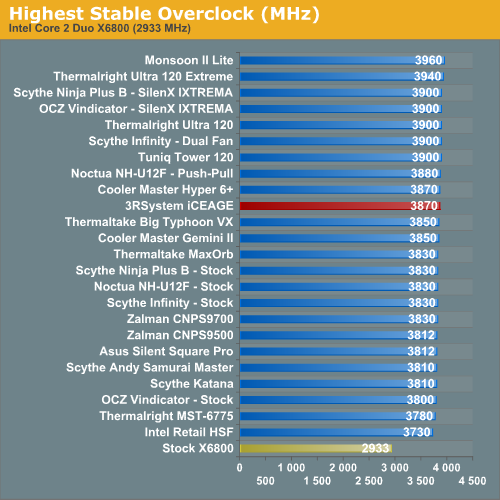
The 3RSystem iCEAGE reached a stable 3.87 GHz, which is similar to other second tier heatpipe towers. This is better than any down-facing cooler and just below the 3.90GHz to 3.94GHz of the top performing heatpipe towers. This is comparable to several other heatpipe towers tested with just one fan. The performance is competent but doesn't lead the pack with the top heatpipe towers reaching 3.90 to 3.94GHz with the same CPU on the same test bed.
Noise
For many enthusiasts upgrading cooling the goal is maximum stable overclock, and they will live with the inconvenience of a louder system. For other users silence is the most important factor, and these users will forgo maximum overclocking if that increases system noise levels.
There are very few power supplies that do not have a fan. While Zalman and a few others do make expensive fanless power supplies, we have not seen a fanless unit larger than 500W, or one that would be used for seriously overclocking a system. With that in mind the noise level of the system with all fans turned off except the PSU was measured. The power supply used for the cooling test bed is the OCZ PowerStream 520, which is one of the quieter of the high performance power supplies.
We have also measured the Corsair 620W and Mushkin 650W power supplies which are reported to be quieter than the OCZ. Both the Corsair and Mushkin are indeed quieter at idle or start up speed. However as soon as load testing begins and the PSU fan speed kicks up the measured noise level is almost exactly the same as the OCZ PowerStream 520W.
We are currently in the process of reevaluating our cooler test bed and planning some updates. The new configuration will include a "quieter" power supply with variable speed and noise levels. We will also update to a P35 chipset motherboard with all passive cooling to the chipset. Changes to the test bed will appear as part of a future roundup with the motherboard, PSU, and CPU all upgraded to more current configurations. We are also investigating a change to a quad-core processor as a further challenge to CPU cooling.
The noise level of the power supply was 38.3 dB from 24" (61cm) and 47 dB from 6" (152mm). The measured noise level of the test room is 36.4 dB, which would be considered a relatively quiet room with a noise floor slightly below the OCZ PowerStream 520 PSU.
Noise levels were measured with the 3RSystem iCEAGE fan at both low 1000rpm and high 2200rpm speeds. Both low and high measurements were taken at both the 6" and 24" distances above the cooling fan on an open case side. Results were then compared to the other coolers/fans tested in this category. Measured noise levels in this chart should be considered worst case. Measurements were taken with an open side of a mid tower case 6" and 24" from the HSF. Real world would be a completely closed case with a further reduction in noise. Please look for both low and high speed results in the noise graphs.
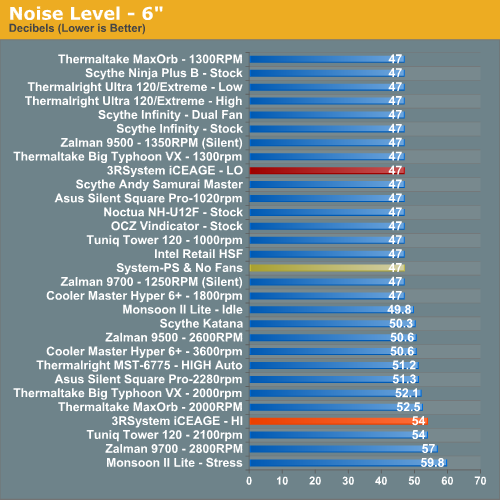
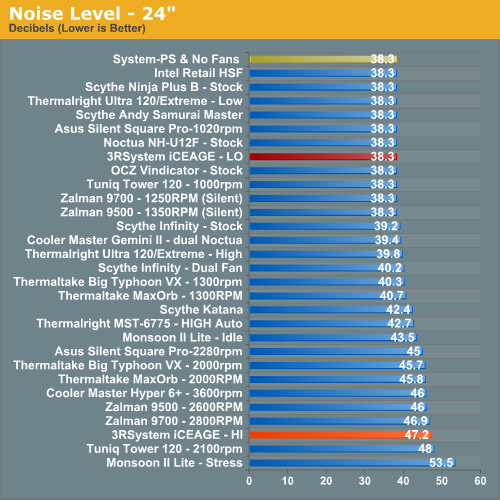
The measured noise levels at 6" and 24" are all below the system noise floor at the low 1000rpm speeds. However noise goes up appreciably as the fan speed is increased to 2200rpm - at both distances. The iCEAGE actually specifies a 19dbA to 32dbA noise range for the included fan, but we do not know the test conditions used for measuring noise. Our noise measurements are higher, but our measurement procedure is more demanding than many noise measurement tests. This is another way of saying the specified noise results may be accurate if we had used the same measurement procedures used by 3RSystem.
The iCEAGE fan is definitely audible at high speed, but the noise is not particularly irritating in frequency. The noise audibly disappeared in a fully closed case, but it still will bother those very sensitive to system noise. If you are very sensitive to noise you should definitely run the iCEAGE in a closed case, and reduce the fan to a level about 25% or more down from the maximum speed.
Conclusion
As our database of tested coolers grows, we see patterns start to emerge. To this point the heatpipe towers with side-facing fans are the top-performing coolers we have tested, in both overclocking ability and cooling efficiency. The 3RSystem iCEAGE performs in that category, with performance matching many other well-recognized brands of heatpipe towers.
The iCEAGE does not, however, reach the top of the heatpipe tower list. That is still the domain of the Thermalrights, Tuniq Tower 120, and a few push-pull configured towers. Performance for the iCEAGE falls in the tier 2 of heatpipe towers, with many other excellent heatpipe towers that overclock to just a hair below the top tier with cooling efficiencies not quite the top level. Like almost every other heatpipe tower, however, the iCEAGE generally outperforms the down-facing fan designs.
This makes the iCEAGE a very pleasant cooler with performance that is very competent. If 3RSystem makes a slight modification to allow mounting of 2 fans the iCEAGE might even join the Scythe Infinity, Scythe Ninja Plus Rev. B, and OCZ Vindicator at the top 3.90 overclock. This would be a simple change in manufacturing and it would make the iCEAGE even more competitive.
iCEAGE does excel in the area of installation. It is one of the most secure installations we have seen, which is particularly impressive considering how easy the iCEAGE is to install. If 3RSystem can just raise the mating pins on the back of the CPU block a bit for a more positive lock it will be all but perfect. When you see so many horrible install procedures from major names in cooling, you wonder what it takes to get an installation right. 3RSysytem obviously figured it out and got most things right as a new name in cooling. They are to be congratulated for their efforts, because the installation is truly simple and very stable.
Perhaps the suggestion we can make to many established names in cooling is to throw out your current install procedures and take a fresh look. There are better ways to do it, and the iCEAGE is one example of a much better installation method.
The iCEAGE is an excellent first cooler from a new name in air cooling. 3RSystem pride themselves in their Research and Development capabilities, and that talent shows in the design of iCEAGE. The cooler can be improved in a few areas with some simple changes, and we do hope 3RSystems will consider our suggestions.
You can get slightly better performance from our top tier heatpipe towers, but if you do decide to buy an iCEAGE you will likely not be disappointed. Performance is near the top, the design is the best heatpipe tower configuration, the variable speed high-output fan is effective, and installation is about as good as it gets. The biggest problem you may have is finding an iCEAGE for sale with such limited distribution in some parts of the world. When you do find iCEAGE for sale 3RSystems also tells us you will be pleased with the price. We are told the iCEAGE retail pricing will generally be at or below comparable offerings from other manufacturers.







